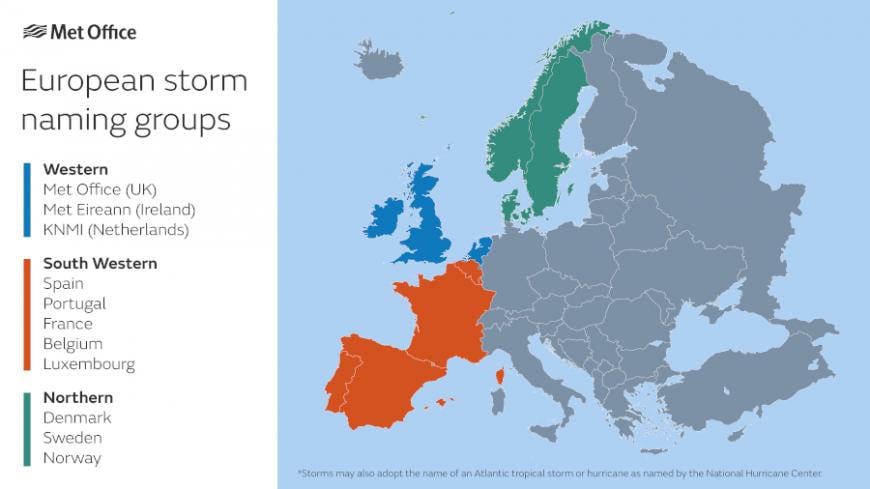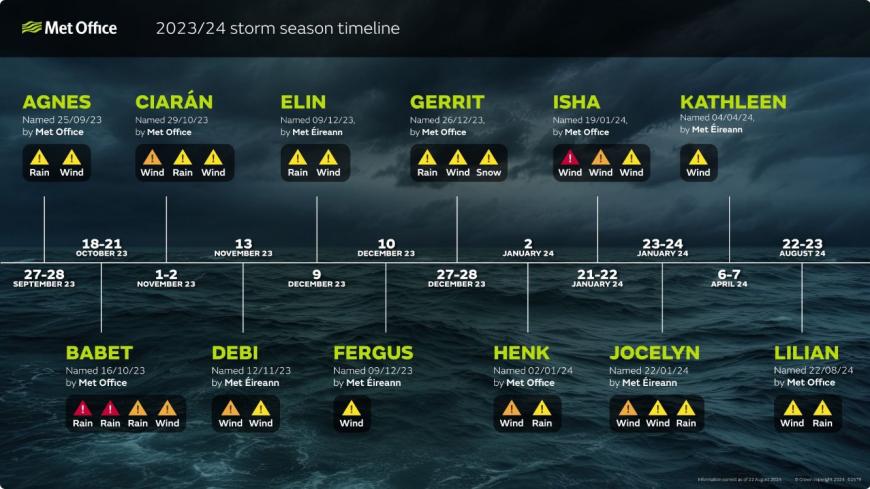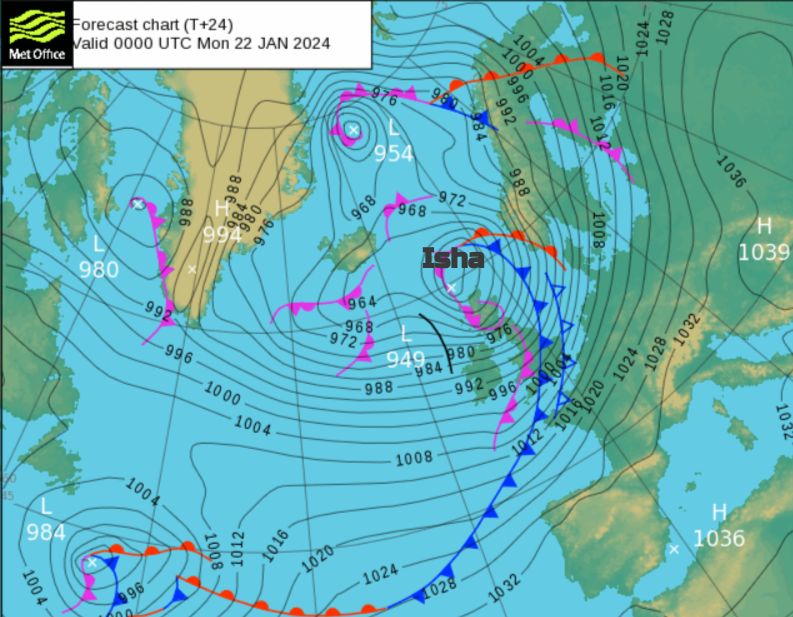
The new list of storm names has been announced for the 2024/2025 season which begins on the 1st September. This time we will start with Storm Ashley, followed by Bert and Conall. James, Mavis and Otje are also included. The UK Met Office is in a naming group with Ireland’s Met Eireann and KNMI in the Netherlands. So there are, perhaps unfamiliar, Irish or Dutch names on the list. The aim is to raise awareness of upcoming severe weather.
KNMI supplied Bert, Éowyn, Floris, Gerben, Kayleigh, Otje and Rafi after taking suggestions at an event in Utrecht in April. Éowyn comes from a character in the film Lord of the Rings and a fair visitor said that the name ‘Gerben radiates strength’ and therefore would be suitable for a storm. Other suggestions were more personal, Kayleigh was the name of someone’s girlfriend.
Met Éireann’s contributions have been taken from a list of more than 500 suggestions by primary school children. They were participating in an event last February resulting in Conall, Darragh, Hugo, Izzy, Naoise, Poppy and Vivienne.
If you are excited by a name in the second half of the list don’t hold out too much hope. Although we did reach L for Lilian in the 2023/24 season this was the highest number of named storms. 2022/23 only saw two named storms, so it can vary a lot. The ‘Name our Storms’ project started back in 2015 and there have been 63 named storms over the nine years from the Western group. The names come from people’s suggestions, historical weather figures, prominent meteorologists and an online Met. Office list which is open to the public.

There are various collectives around Europe where neighbouring countries join together, producing an annual alphabetical list ready for the autumn and winter low pressures that may impact their shores. There can be the occasional summer storm as we saw in 2024 with Storm Lilian on the 23rd August.
France, Portugal, Spain, Belgium and Luxembourg are in the Southwestern Group which was created for the 2017/18 season and they reached R for Renata last season. The various National Meteorological and Hydrological Services (NMHS) of Europe
“aims to name only storms that can potentially have a major impact on property and people”
Storms named by France can impact southern England, such as Storm Alex late in September 2020. Our Storm Aiden didn’t appear until the end of October, so the list can be interrupted.
There is a Northern naming group too, comprising of the Norwegian, Swedish and Danish Met services. Their named storms have impacted the UK as well, such as Malik and Otto. Generally, it is the country that will be most impacted that names the storm, but this is another grey area in the protocols of how and when a low pressure receives a name.
Impacts are not necessarily the same as highest rainfall amounts or strongest wind gust. Northwestern Scotland can take plenty of rain and gales without seeing many impacts. Bournemouth seeing the same weather on a Bank Holiday Monday or the M25 for Friday evening rush hour would cause disruption, but is that enough for a Storm name?

If the weather conditions are forecast to be severe enough to warrant a red warning, with high likelihood and high impacts, then a storm name is very likely. Usually, the heart of an event is a windstorm but, as for Storm Desmond, severe and persistent rainfall (even heavy snow) can produce a named low. Storm Babet in mid-October 2023 saw torrential, ongoing rain and coastal damage with wild winds but it will be remembered for the severe widespread flooding.
It once was the case that if the event reached Amber status or was likely to reach Amber warning status, that would qualify for a name but this criterion has faded away. You can see on the timeline above that Agnes, Gerrit and Lilian only reached Yellow warnings. These were named by the UK Met Office. Obviously, Met Eireann’s timeline would be different for the storms which they named.

Overall the naming is a communications tool. The label ‘Storm Bert’ grabs attention and will hopefully get people talking/typing about an upcoming weather event. The official severe weather warnings contain regional information with timeframes, weather details and forecast impacts. Analysis has shown that there is a huge lift in media and public engagement once a name has been issued. Television broadcasters may hope for more timely issuing to catch their morning or late evening news programmes but for digital online services, any time is fine for updates. By grabbing attention with a storm name it is hoped that more people and businesses will prepare. Also, that behaviour will change once they have absorbed quality, clear information and updates about the upcoming severe weather. As our climate continues to warm and severe weather events increase, people and communities have to become more resilient. They need to know how to access the right information in a timely, useful manner and act on it. As they prepare, the local authorities and emergency services can focus on those who can’t help themselves.
What works against this is poor-quality information and blatantly untrue clickbait stories which make weather forecasters groan. This is a wider UK weather problem but please, just don’t share these links. Maybe the list shouldn’t be published in advance? Would that stop ‘The Daily whatever’ from jumping the gun, again and again with any old Atlantic low?

A few of the names are from the UK Met Office’s history including James, Lewis and Mavis.
Group Captain James Stagg, whose weather forecast was credited with convincing General Eisenhower that the WWII D-Day invasion should be pushed back 24 hours to avoid a storm and potential catastrophe.
Lewis Fry Richardson, was an English mathematician, physicist, meteorologist, psychologist and pacifist who pioneered modern mathematical techniques of weather forecasting He devised a theory to use maths and physics to make weather forecasts using computers. But his career path was often diverted by the interruptions and demands of war and military associations.
Mavis Hinds, who undertook pioneering work on the earliest Met Office computers. She became an expert in writing, running and correcting computer programs for weather forecasting. And one of the first females to play a leading role in the development of Numerical Weather Prediction, not only in the UK but also worldwide.
How to suggest a name?
“Everyone is welcome to suggest names for future consideration via email to [email protected] or through our online form. “
You can suggest up to five names and share your reasons but it might be worth looking at the previous lists first. Other Met services run similar collections. In Germany, you can sponsor a High or a Low pressure and have it named. The separate list starts will appear on Sept 18th for 2025. 2024 sold out as it is a popular entertainment. Summer storm Poly hit Germany, and the Netherlands, in July 2023 with code red wind warnings and rain stopping play at Wimbledon.
Some of these storms become memorable, like Arwen, Babet and Eunice. Others less so perhaps, if they impact Ireland, sometimes the Netherlands more than the UK. We will await Storm Ashley and any others that follow.
More discussion about the Name our Storms project in the Netweather community forum
Loading recent activity...